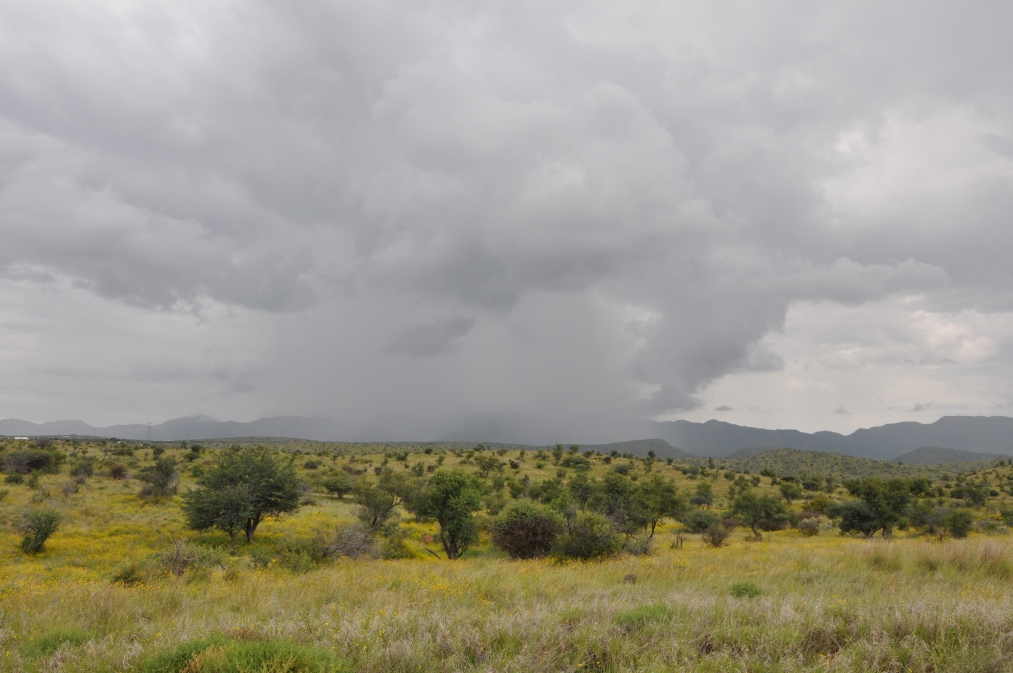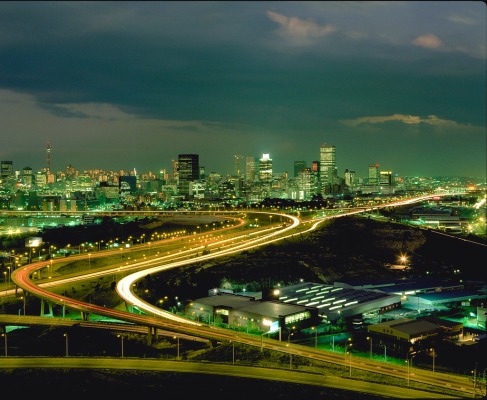No one is allowed to be out in the game reserve at night but the camp gates open at 6:50 am for optimal early morning wildlife viewing. Animals are early risers and in the high grass I swear I saw the long spotted tail of a cheetah. We immediately scrambled a top the roof of our car for a better look but the cat had already disappeared! For the most part however the park was serenely quiet with herds of grey gemsbok wading ghostlike through the morning mist. At checkout at the lodge I flipped through the guest book and was shocked at all the critical comments. After every three or four entries of your typical compliments and thanks would be an extremely spiteful entry attacking the food, the service, or the condition of the roads. One entry even made the horribly racist suggestion that the lodge implement some white management. Other guests in the book rushed to the staff’s defense, insisting in the margins with capital letters and triple underlines that the bigoted ‘Mr. Bauer’ go home and take his racist attitude with him. The very last entry read, “Super-Duper. Please if this place is so objectionable to you, don’t come back as you bring your own fragile, overreactive neurology with you.” Thank you to Mr. A. Fellows from Vancouver, Canada for so perfectly summarizing and assessing the most bizarrely intriguing and offensive guest book I’ve ever read.
From Etosha we stopped over for lunch at the town of Outjo. The environment in Outjo was surreal and even hostile. People hung outside the local supermarket looking wary and hungry. Boys fighting in the parking lot were broken up by a police man with a giant whip. At a listless crafts fair across the street a man came up and enquired our names which he then began to scratch into his forearm with a razors edge. He didn’t press deep but I hastily told him to stop. At the roadside I saw three Himba women sitting under a tree with their babies. If anyone has seen the movie ‘Babies’ the baby from Africa is born to a Himba woman. The wikipedia run-down on the Himba is that they are an ethnic group closely related to the Herero who live mainly in the northern Kunene region of Namibia.They are a nomadic, pastoral people who have miraculously maintained their traditional dress (or lack thereof). The Himba wear only a loin cloth, some jewelry and metal bangles around their ankles to protect them against snake bites in the bush. The woman are famous for rubbing their bodies in otjize, a mixture of butter fat and ochre. The mixture dyes their skin a permanent, luminescent orange symbolizing the earth and their own life-giving blood. They also braid their hair and cake it in the ochre dye, giving them thick, stiff, russet-colored dreads. The Himba women glowed a radiant orange in the sun as they aggressively sold their small crafts, tying bracelet after bracelet onto my unwilling wrists. I bought two carved out of cow horns and walked away with their orange powdered finger prints all over my hands and arms. The perfumed skin dye is used as a substitute for washing and the Himba women have a potent, acrid, almost smoky body odor. From the moment of meeting them onwards I have been revisited at random by the arresting memory of their smell.
As we walked through Outje school children came flooding into the streets as they were dismissed for the day. From one side of town came the black school children and from the other came a stream of white school children. The white children looked like they were straight out of the foothills of German folklore. With their tan trousers, suspenders, and leather book bags they looked like something off the set of a Sound of Music remake. There is also something incongruous to see a stream of blond heads and blue eyes set off from all the black faces in town. On the whole these kids were beaming with health and privilege as their parents idled by the roadside ready to pick them up in air conditioned SUVs. The pattern, I’ve found, is the same at every stop where the majority of the forlorn-looking small-town population is black. Then there is a white German sub-population that is unmistakably wealthier and owns the German bakeries, restaurants, beer gardens, and B&B’s which are in turn filled almost entirely with white, European travelers. For anyone who is unfamiliar with the history, Namibia was Germany’s one big territorial claim in Africa. In 1883 a German trader named Adolf Luderitz bought land from a local chief on the southern coast of Namibia and founded the city of Luderitz. Eager to gain colonial possessions abroad, Germany annexed the territory and named it their own South-West Africa. Germans immigrated as soldiers, traders, diamond miners, and colonial officials and continued to live in the territory even as Germany lost their holding in the aftermath of WWI. The territory then came under the control of South Africa until its own independence in 1990. Today about 6.4% of the 1.4 million population of Namibia is white, mainly of German descent. The largest ethnic group are the Ovambo weighing in at about 50% of the population. The Herero make up 7.5%, a small statistic which conceals a massive tragedy. The Herero would have made up a far greater proportion of the population if 100,000 of their numbers had not been ruthlessly exterminated in the first genocide of the 20th century. In 1904 Samuel Maharero lead his people in a rebellion against German colonial rule. The Herero were defeated and driven into the desert where most of them died of thirst and starvation. The United Nations declared the event a genocide in 1985 and the German government issued an official apology in 2004.
Before leaving Outje we stopped off at a German Bakery, literally a high-walled sanctuary of coffee and free wifi. All the diners are white and the dusty streets are blocked from view by the leafy trees and gurgling fountain in the paradisal beer garden. Although my heart sings at the sight of a cappuccino and reliable internet connection, my stomach also tightens with a confused mix of guilt and shame at my inclusion in this unintentionally exclusive environment. Our implicit inclusion is reinforced by our appearance and German surname, both of which elicit greetings in German which we are linguistically ill-equipped to reciprocate. Although I am grateful for the warmth and generosity expressed by white Namibians, I am equally bothered by the mysterious wall I feel between myself and the black Namibia population. I feel as though some mysterious matrix of automatic assumptions and latent resentments subtly denies the possibility of a perfectly natural and comfortable personal interaction. Curiously, this barrier is noticeably less pronounced in Botswana even as the socioeconomic, racial, and cultural gap remains just as wide. My head swarms with possible explanations but I ultimately feel ill-equipped to answer for this peculiar but palpably felt difference. My intuition however points overwhelmingly to their divergent colonial histories. The presence of a colonial history in Namibia and its conspicuous absence in Botswana accounts in turn for the presence or absence of the curiously felt racial barrier between myself as a white American and a black Mostwana or Namibian.
From Outjo we kept pushing south through the small dusty town of Khorixas before turning onto unpaved C35, our highway to the coast through miles and miles of bleak desert. The land was flat and uninhabited in all directions, a vast, remote, and indifferent expanse. Empty place that fills you with melancholy. Only slight color variations in the sand seemed to mark the passing miles. Faced with so much time and space my thoughts became slow and heavy brooding upon themes of isolation and neglect. Every few miles we saw corrugated tin houses set back from the road, simmering unsheltered in the merciless glare of the midday sun. Wooden shacks selling small crafts by the roadside sat uninhabited as sad totems to a meager economy and pervasive deprivation. The few people we did pass motioned imploringly for our business, our food, or our water. They looked abandoned in and by the world. My dads mood wasn’t as affected but he noticed mine and suggested I try driving to shake my despondency. Learning to drive stick for the first time shifted my mood from first gear listlessness to sixth gear terror. There was a lot of sudden stops and starts but not a single living creature around to judge. Scrub and sand finally gave way to the mountains of the Damaraland. The reassuring bulk of the mountains on the horizon line helped anchor my lost sense of space and time. We overshot our turn off and drove up to a B&B on the edge of Uis. It was surreal and almost unsettling to drive into a courtyard of potted plants and find a friendly receptionist in the middle of the desert. Three absurdly friendly Dachshunds scrambled into my lap as I sat there dumb and still disoriented from the desert. I was unexplainably relieved when my dad voted to drive on to another spot for the night. We turned back into the desert and drove straight into the granite embrace of the Brandberg mountains. We drove down a narrow dirt path surrounded on all sides by rolling plains burning gold in the light of the setting sun. Herds of Springbok leapt gracefully across the plains and we found a small band of horses grazing by the roadside. We stopped to take pictures, especially of the chestnut foal who hung shy and fragile in his mothers shadow. We stood there in splendid isolation reveling in the light of the burning sunset as uncounted moments of purest appreciation passed by. I’m hesitant to identify just one moment to call the best from the trip, but if I were to choose, this was the best. Sunlight filtered through the glass-bottled beers in the car as we drove through the slow-motion scattering of a herd of cattle in the road. Once the sun fell behind the mountains their towering peaks doused the burning plains in giant cool shadows. Our accommodation for the night was the White Lady Lodge, named for local ancient cave paintings of a mysterious pale female figure. We drove up as the sky turned a luminous royal blue. Being the off season we ate dinner on a pleasantly deserted porch front in the company of the stars and the crickets.












